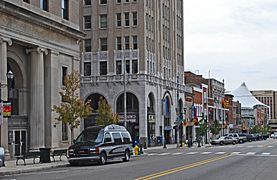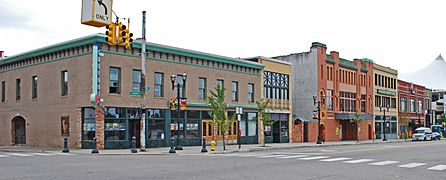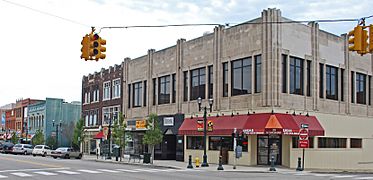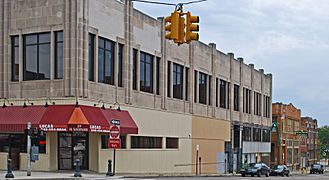Pontiac Commercial Historic District facts for kids
|
Pontiac Commercial Historic District
|
|
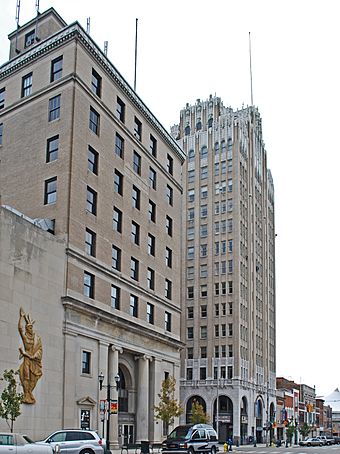
Corner of Lawrence and Saginaw
|
|
| Location | Roughly E. Huron St. and S. Saginaw St. within loop of Wide Track Dr., Pontiac, Michigan |
|---|---|
| Area | 2.1 acres (0.85 ha) |
| Built | 1865 |
| Architect | Smith, Hinchman & Grylls, other |
| Architectural style | Early Commercial, Gothic, Tapestry Brick, Renaissance Revival |
| NRHP reference No. | 84001817 (original) 89000491 (increase) |
Quick facts for kids Significant dates |
|
| Added to NRHP | February 16, 1984 |
| Boundary increase | June 23, 1989 |
The Pontiac Commercial Historic District is a special area in Pontiac, Michigan, known for its old and important business buildings. It's located mostly along East Huron and South Saginaw Streets. This district was first recognized as a historic place in 1984. Later, in 1989, it was made even bigger to include more historic buildings.
This district is home to some other famous spots too, like the Eagle Theater and the Grinnell Brothers Music House. These places are also listed on the National Register of Historic Places, which means they are very important to history.
Contents
History of Pontiac's Downtown
Pontiac was started a long time ago, in 1818-1819, by a group of people who wanted to invest in the area. Soon after, in 1819, Oakland County was created, and Pontiac became its main town. By 1820, Pontiac was growing fast. It already had a dam, a sawmill (for cutting wood), a flour mill (for making flour), and a blacksmith shop (where metal was worked).
A courthouse was built in 1824. By 1830, Pontiac was clearly the most important place for business in the county. However, in 1840, a big fire destroyed the entire business area. But the people of Pontiac quickly rebuilt! Many of the buildings that were put up after the fire, especially those facing North Saginaw Street, are still standing today.
The city's industrial growth really took off in 1886. That's when a local businessman, Charles V. Taylor, opened a factory that made carriages. By 1900, most of the men working in Pontiac were making carriages and buggies.
Around 1907, these factories started changing to make cars instead. In 1909, a huge company called General Motors bought many of these independent factories. This led to a massive increase in Pontiac's population. With more people, the downtown area needed to be rebuilt again. Many of the buildings you see in the district today were built between 1900 and 1930, during this exciting time of growth.
Exploring the Historic District
The Pontiac Commercial Historic District covers parts of sixteen city blocks in downtown Pontiac. The very first part of the district, recognized in 1984, is just one block. This block has sixteen buildings, and fourteen of them are considered "contributing." This means they are old and important to the district's history.
The rest of the district, added in 1989, has 84 more buildings. Out of these, 53 are also "contributing" to the historic feel of the area.
Buildings from the Early Days
The oldest part of the district, from 1984, is one block. It's surrounded by Saginaw, Lawrence, Pike, and Wayne Streets. The buildings here are mostly two or three stories tall and made of brick. They are all commercial buildings, meaning they were used for businesses.
The eastern side of this block, facing Saginaw Street, was completely rebuilt after the 1840 fire, before 1865. Most of these very old buildings are still there. They run from 1 to 21 North Saginaw. Many of them were updated in the 1910s and 1920s, so you can see different building styles on their fronts. Other buildings on this block, facing Lawrence and Pike, were built later, in the 1910s and 1920s.
More Historic Buildings Added Later
The buildings added to the district in 1989 were mostly built during Pontiac's big growth years, from 1900 to 1930. However, there are also some older buildings from the late 1800s. You can see many different styles of architecture here. Some are from the 19th century, like the Second Empire and Late Victorian styles. Others are from the 20th century, like Neo-Classical Revival, Renaissance Revival, and Art Deco.
Here are some of the important buildings in the district:
- Turk Building (71-75 North Saginaw): Built in 1900, this is one of the oldest and largest buildings in the district. It's a three-store-wide building with cool brickwork.
- The Strand (Campus) Theatre (12-14 North Saginaw): This building used to be a theater. Even though the inside has changed, its front still looks fancy with special decorations.
- Post Office (now the Furlong Building) (35 East Huron): Built in 1910, this old post office is made of limestone. It has a row of big, beautiful columns across its front.
- The Eagle Theatre (15 South Saginaw): This theater has a unique Moorish style. It's also listed on the National Register of Historic Places.
- Grinnell Brothers Music House (27 South Saginaw): This building has a somewhat Gothic look. It's another building in the district that is also listed on the National Register of Historic Places.
- Masonic Temple (1 Lafayette): Built in 1923, this building has a very special design, unique to Michigan. It features double and triple-arch windows set inside slightly recessed archways.
Gallery


